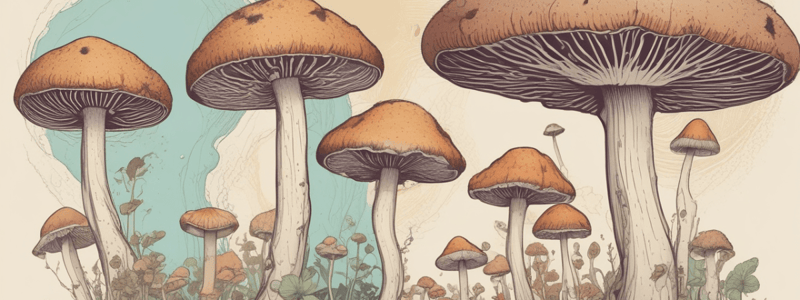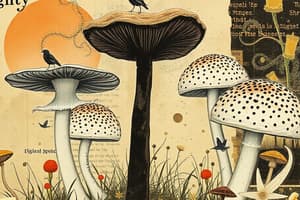Podcast
Questions and Answers
Which organelles are found in fungi?
Which organelles are found in fungi?
- Chloroplasts, Cell membrane, Ribosomes
- Nucleus, Vacuoles, Mitochondria (correct)
- Endoplasmic Reticulum, Vacuoles, Chloroplasts
- Nucleus, Ribosomes, Chloroplasts
What are the two main groups of fungi?
What are the two main groups of fungi?
- Moulds and Mildews
- Filamentous fungi and Yeast (correct)
- Algae and Fungi
- Bacteria and Yeast
Which of the following is NOT a characteristic of filamentous fungi?
Which of the following is NOT a characteristic of filamentous fungi?
- Can produce sexual spores
- Spores are numerous and spread easily through air
- Reproduce by budding (correct)
- Often contain many nuclei in cells of hyphae
Which is a method by which yeasts can grow?
Which is a method by which yeasts can grow?
What substance is commonly found in the cell walls of fungi?
What substance is commonly found in the cell walls of fungi?
Which of the following fungi is NOT an example of filamentous fungi?
Which of the following fungi is NOT an example of filamentous fungi?
What is the primary reproduction method of yeast?
What is the primary reproduction method of yeast?
What do mushrooms produce that can be dispersed through the air?
What do mushrooms produce that can be dispersed through the air?
Which form do dimorphic fungi take at environmental temperatures?
Which form do dimorphic fungi take at environmental temperatures?
What is one use of fungi in biotechnology?
What is one use of fungi in biotechnology?
Which infection is associated with fungi?
Which infection is associated with fungi?
Which fungus is known to switch between yeast and filamentous forms and is involved in pathogenicity?
Which fungus is known to switch between yeast and filamentous forms and is involved in pathogenicity?
Which of the following fungi are extensively used in antibiotic production?
Which of the following fungi are extensively used in antibiotic production?
Which of the following is a benefit of fungi?
Which of the following is a benefit of fungi?
Which product is NOT derived from fungi in the biotechnology industry?
Which product is NOT derived from fungi in the biotechnology industry?
Which antibiotic is produced by fungi and is antifungal?
Which antibiotic is produced by fungi and is antifungal?
Flashcards are hidden until you start studying
Study Notes
Characteristics of Fungi
- Contain nucleus, vacuoles, and mitochondria
- Spore-bearing and can reproduce sexually or asexually
- Cell walls are made of polysaccharides, cellulose, and/or chitin
- Saprophytic and play a crucial role in decomposition
- Over 100,000 known species, but only a few are clinically important
Classification of Fungi
- Divided into two groups: filamentous fungi (moulds) and yeast
- Filamentous fungi have hyphae that extend through transverse divisions, forming a mycelium
- Yeast are single-celled organisms that reproduce by division or budding
Filamentous Fungi
- Examples include Aspergillus, Penicillium, and Trichophyton
- Composed of surface mycelium, aerial hyphae, and cells with many nuclei
- Conidia (asexual spores) are found at the end of hyphal branches and are easily dispersed through the air
- Often contaminate laboratories and can cause allergies
Life Cycle of Filamentous Fungi
- Involves conidiophore, germination, conidia, aerial hyphae, subsurface, and hyphae
Characteristics of Colonies
- Appear dusty on agar plates
- Often brightly colored
- Some species produce sexual spores that are resistant to drying, heating, and freezing
- Can produce fruiting bodies and mushrooms that produce sexual spores
Yeast
- Examples include Candida, Saccharomyces, and Cryptococcus
- Unicellular and grow by budding or fission
- Some species, like Candida albicans, can form a filamentous phase involved in pathogenicity
- Dimorphic fungi can switch between mycelial and yeast forms depending on temperature
Importance of Fungi
Benefits
- Used in food production, nutrient cycles, antibiotic production, fermentation, pest control, and molecular biology
Hazards
- Can cause infections, produce toxins, spoil food, cause decay, and act as plant pathogens
Fungi in Food
- Mushrooms are a type of fruiting body produced by filamentous fungi
- Quorn is a fungal protein used as a vegetarian meat substitute
- Yeast tablets are a dietary supplement rich in protein and riboflavin
- Moulds are used to ripen cheeses
Antibiotic Production
- Most antibiotics are produced by filamentous fungi, especially Streptomyces spp.
- Species of Aspergillus and Penicillium are also used in antibiotic production
- Other antibiotics produced by fungi include fumigillin, griseofulvin, and cephalosporins
Fungi in Biotechnology
- Used to produce chemicals, pharmaceuticals, citric acid, kojic acid, itaconic acid, steroids, glycerol, ethanol, and enzymes like amylases and penicillin acylase
Studying That Suits You
Use AI to generate personalized quizzes and flashcards to suit your learning preferences.




